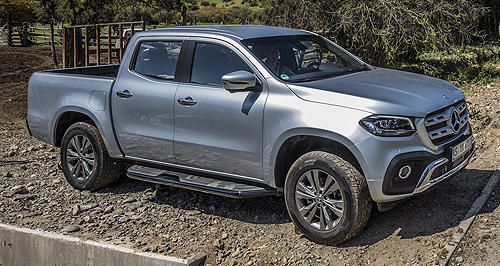Mercedes-Benz X-Class gains width for the greater good
BY BYRON MATHIOUDAKIS | 24th Oct 2017

Speaking to GoAuto at the launch of the X-Class in Chile last week, Mercedes-Benz director of design brands and operation, Kai Sieber, said that while there were constraints to what could be achieved within the existing structural hard points of the Nissan ladder-frame chassis, the resulting extra 70mm of body width outside of the vehicle has translated to nearly that much more inside, boosting ergonomics and refinement as well as interior space.
“We were able to change the proportions over the Navara,” he said. “I wanted to have more width … and that has translated in a number of improvements for occupants … as well as benefiting the design.
“The inner cabin is 50mm wider than in the Navara, and on top of that we are 70mm wider in the track to enable the shoulder to be wider and that you can feel that in the interior. We took it as wide as we wanted and we needed it to be… but of course, from a designer’s point of view, no vehicle can ever be wide enough.”While the X-Class and Navara might appear similar in silhouette, in fact no body panels are shared saved for some of the glass parts and door handles, with the wider body accompanied by a subtly raised rear roof section that in turn improves back-seat headroom by a small but important degree.
“You can see it in section how there is a small step a few millimetres in to help with interior space,” he explained. “So, there is now a bit more room for head clearance.”From a packaging point of view, the extra width and height also gave Mercedes’ engineers the opportunity to fit a raised and better padded rear-seat cushion, to help reduce the ‘knees up’ seating position that quickly leads to discomfort in many one-tonne pick-ups. The angle of the backrest was also altered for the same reason.
“This means people do not have to sit with their legs bunched up like this,” Mr Sieber demonstrated.
Furthermore, the extra body width allowed for extra sound-deadening material to be fitted in areas such as around the transmission tunnel, reducing noise, vibration and harshness properties.
“This leads to less fatigue for occupants”, Mr Sieber said.
Finally, while Mercedes’ engineers were limited by the Navara’s lower centre-console positioning of the heater, ventilation and audio systems, the Germans were able to switch to their more compact components as used in other models.
In turn, this freed up space for items it perceived as essential brand equipment, such as the touchpad controller that operates the central screen and multimedia set-up.
“We had to work within the hardpoints of the Nissan like the climate control sitting down low, so we had to build up our own packaging components from our own car lines from the C-Class and V-Class,” Mr Sieber said.
“We had to package all of our elements from our side, and that was really tough to package that all together and get all the functions we need in the centre console.”
